Do you have a question about the Samsung PN50A550S1FXZA and is the answer not in the manual?
Samsung Canada customer care center contact details and website.
Samsung USA customer care center contact details and website.
Guidelines for viewing wide-screen format PDP displays to avoid screen aging.
Details of Samsung's limited warranty repair service in North America.
Instructions on preventing and understanding screen image retention and burn-in.
Information on altitude limits, heat dissipation, cracking noise, and cell defects.
Overview of the TV's main features and capabilities.
List of items included with the TV and instructions for missing items.
Explanation of the functions of the TV's front panel buttons.
Details on the rear panel jacks for A/V component connections.
Details on the side panel jacks for occasional device connections.
Explanation of each button on the remote control and its function.
Instructions for connecting VHF/UHF antennas using different lead types.
Instructions for connecting cable boxes that descramble channels.
Guide to connecting DVD players or cable boxes using HDMI for high quality.
Guide to connecting devices using DVI output for video and audio.
Instructions for connecting DVD/Cable Box via component cables.
Instructions for connecting a camcorder to view tapes without a VCR.
Guide for connecting a VCR using video and audio cables.
Instructions for connecting a VCR using S-Video for better picture quality.
Connecting a digital audio system or home theater receiver via optical cable.
Connecting an amplifier or DVD home theater via audio cables.
Guide for connecting a PC to the TV using a D-Sub cable.
Guide for connecting a PC to the TV using an HDMI/DVI cable.
Instructions on how to turn the TV on and off using the remote or panel.
Initial TV setup for language, channels, and time.
Methods for changing channels using buttons, numbers, or PRE-CH.
Instructions for increasing, decreasing, or muting the TV volume.
How to view current channel and audio-video setting status.
Guide to accessing and navigating the TV's main menu structure.
Accessing frequently used functions quickly via the TOOLS button.
Steps to select signal source and memorize channels automatically.
Guide to selecting the TV's input source from available devices.
Instructions for renaming input sources for easier selection.
Selecting picture modes like Dynamic, Standard, or Movie.
Adjusting detailed picture settings like Cell Light, Contrast, and Brightness.
Adjusting black level depth and primary color intensity (Gamma).
Adjusting screen contrast for optimal viewing.
Selecting Auto, Native, or Custom color space for natural color.
Adjusting color temperature and emphasizing flesh tones.
Enabling xvYCC for enhanced detail and color space in HDMI/Component modes.
Selecting and adjusting color tones like Cool, Normal, Warm.
Activating DNle for improved visual quality with 3D noise reduction.
Adjusting the black level of the picture while in HDMI mode.
Setting the TV to automatically process film signals for optimal picture.
Function for adjusting color and tint using a blue filter effect.
Using white screen or scrolling to remove screen burn artifacts.
Restoring picture settings to factory default values.
Activating and configuring the PIP feature for simultaneous viewing.
Selecting the desired position for the PIP window on the screen.
Selecting the antenna source and desired channel for the PIP window.
Selecting sound modes like Standard, Music, Movie, or Speech.
Adjusting sound settings such as equalizer and sound mode.
Selecting the preferred audio track language for digital broadcasts.
Selecting Mono, Stereo, or SAP for analog audio tracks.
Reducing volume level differences between broadcasters.
Turning the TV's internal speakers on or off.
Listening to the sound of the sub (PIP) picture.
Restoring sound settings to factory default values.
Adding, deleting, or setting favorite channels for digital broadcasts.
Deleting or adding channels to display desired channels.
Setting frequently watched channels as favorites.
Automatically switching to a reserved channel even when watching another channel.
Viewing, modifying, or deleting existing program reservations.
Changing reservation details or canceling a viewing reservation.
Assigning names or call letters to analog channels.
Storing channels and their call letters via the auto program function.
Filtering out scrambled channels from the list after auto program.
Manually adjusting analog channels for optimal reception.
Setting up the TV to function as a computer display.
Information on display modes and optimal resolutions for PC input.
Automatically adjusting video signals for optimal PC display.
Removing or reducing picture noise for clearer PC display.
Adjusting PC screen positioning if it does not fit the TV screen.
Resetting all screen position settings to factory default values.
Manually setting the TV's clock for timer features.
Automatically setting the clock using digital signal information.
Choosing the language for the TV's on-screen menu interface.
Setting or changing the Personal ID Number (PIN) for V-Chip access.
Turning the V-Chip feature on or off to lock inappropriate programs.
Setting parental restrictions based on TV's age-based rating system.
Configuring restrictions for TV-Y, TV-Y7, TV-G, TV-PG, TV-14, TV-MA categories.
Setting restrictions based on MPAA ratings (G, PG, PG-13, R, NC-17, X).
Setting parental restrictions for Canadian English content.
Setting parental restrictions for Canadian French content.
Applying parental restriction information for DTV channels.
Adjusting the volume of the TV power on/off melody sound.
Turning the blue LED on the front of the TV on or off.
Selecting optimal display and sound for sports, cinema, or games.
Adjusting settings to reduce power consumption and save energy.
Enables viewing and listening to photo (JPEG) and audio (MP3) files from USB.
Steps to display and navigate the WISELiNK menu.
Displaying photo files and folders saved on a USB memory device.
Explanation of buttons and functions within the Photo List.
Sorting photos by various standards like month, time, or folder.
Detailed steps for sorting photos by month, time, and folder.
Modifying color, composition, and favorite settings for photos.
Instructions for deleting single or multiple photo files.
Displaying detailed information about a selected photo file.
Displaying a selected photo in full screen mode.
Initiating a slide show using selected photos or the current group.
Accessing options like Rotate, Zoom, and Slide Show Speed.
Rotating photos in 90-degree increments during viewing.
Zooming into images and panning across the zoomed view.
Enabling background music playback during slide shows.
Selecting background music modes: Shuffle, Selected File, or Mood.
Displaying and managing MP3 files from a USB device.
Sorting music files alphabetically by title, artist, or genre.
Sorting music files by folder and selecting mood categories.
Setting favorite ratings for music files using star indicators.
Instructions for deleting single or multiple music files.
Displaying detailed information about a selected music file.
Playing a selected MP3 file and controlling playback.
Playing music files within a selected group or folder.
Playing specific selected music files individually.
Setting repeat mode to play music files continuously.
Setting up slide show speed, music repeat mode, and screen saver.
Anynet+ enables control of connected Samsung devices via TV remote.
Instructions for connecting various Samsung devices to the TV.
Enabling the Anynet+ (HDMI-CEC) function for device control.
Searching for and switching between connected Anynet+ devices.
Description of Anynet+ menu items and device control options.
Configuring the TV to output sound through an external receiver.
Solutions for common problems encountered with the Anynet+ feature.
A list of common issues and their possible solutions for the TV.
Steps to access and use the auto wall-mount adjustment menu.
Saving current positions and moving to pre-set positions.

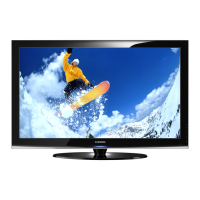


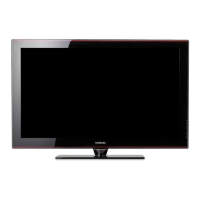



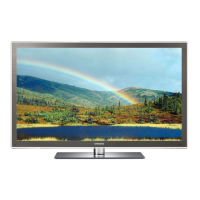
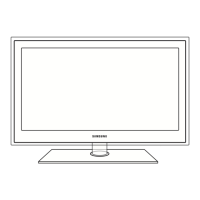
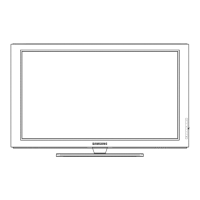

